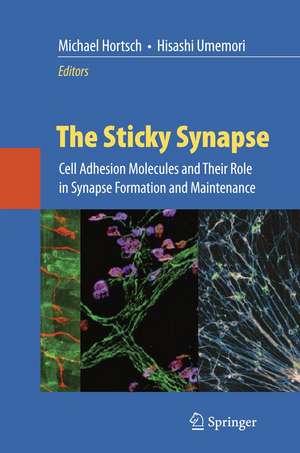The Sticky Synapse: Cell Adhesion Molecules and Their Role in Synapse Formation and Maintenance
Editat de Michael Hortsch, Hisashi Umemorien Limba Engleză Hardback – 7 iul 2009
| Toate formatele și edițiile | Preț | Express |
|---|---|---|
| Paperback (1) | 1007.03 lei 6-8 săpt. | |
| Springer – 10 sep 2014 | 1007.03 lei 6-8 săpt. | |
| Hardback (1) | 1205.11 lei 38-44 zile | |
| Springer – 7 iul 2009 | 1205.11 lei 38-44 zile |
Preț: 1205.11 lei
Preț vechi: 1565.07 lei
-23% Nou
Puncte Express: 1808
Preț estimativ în valută:
230.59€ • 241.41$ • 190.80£
230.59€ • 241.41$ • 190.80£
Carte tipărită la comandă
Livrare economică 01-07 aprilie
Preluare comenzi: 021 569.72.76
Specificații
ISBN-13: 9780387927077
ISBN-10: 0387927077
Pagini: 453
Ilustrații: XII, 453 p.
Dimensiuni: 155 x 235 x 33 mm
Greutate: 0.96 kg
Ediția:2009
Editura: Springer
Colecția Springer
Locul publicării:New York, NY, United States
ISBN-10: 0387927077
Pagini: 453
Ilustrații: XII, 453 p.
Dimensiuni: 155 x 235 x 33 mm
Greutate: 0.96 kg
Ediția:2009
Editura: Springer
Colecția Springer
Locul publicării:New York, NY, United States
Public țintă
Professional/practitionerDescriere
The molecular mechanisms, which are responsible for the functional differences between the various types of neuronal synapses, have become one of the central themes of modern neurobiology. It is becoming increasingly clear that a misregulation of synaptogenesis and synaptic remodeling and dysfunctional neuronal synapses are at the heart of several human diseases, both neurological disorders and psychiatric conditions. As synapses present specialized cellular junctions between neurons and their target cells, it may not come as a surprise that neural cell adhesion molecules (CAMs) are of special importance for the genesis and the maintenance of synaptic connections. Genes encoding adhesive molecules make up a significant portion of the human genome, and neural CAMs even have been postulated to be a major factor in the evolution of the human brain. These are just some of the many reasons why we thought a book on neural CAMs and their role in establishing and maintaining neuronal synapses would be highly appropriate for summarizing our current state of knowledge. Without question, over the near future, additional adhesive proteins will join the ranks of synaptic CAMs and our knowledge, and how these molecules enable neurons and their targets to communicate effectively will grow.
Cuprins
A Short History of the Synapse – Golgi Versus Ramón y Cajal.- Cell Adhesion Molecules at the Drosophila Neuromuscular Junction.- Development of the Vertebrate Neuromuscular Junction.- Synapse Formation in the Mammalian Central Nervous System.- Developmental Axonal Pruning and Synaptic Plasticity.- Cell Adhesion Molecules in Synaptopathies.- The Cadherin Superfamily in Synapse Formation and Function.- Nectins and Nectin-Like Molecules in the Nervous System.- The Down Syndrome Cell Adhesion Molecule.- Molecular Basis of Lamina-Specific Synaptic Connections in the Retina: Sidekick Immunoglobulin Superfamily Molecules.- SYG/Nephrin/IrreC Family of Adhesion Proteins Mediate Asymmetric Cell–Cell Adhesion in Development.- L1-Type Cell Adhesion Molecules: Distinct Roles in Synaptic Targeting, Organization, and Function.- Cell Adhesion Molecules of the NCAM Family and Their Roles at Synapses.- MHC Class I Function at the Neuronal Synapse.- Pathfinding Molecules Branch Out: Semaphorin Family Members Regulate Synapse Development.- Ephrins and Eph Receptor Tyrosine Kinases in Synapse Formation.- Neurexins and Neuroligins: A Synaptic Code for Neuronal Wiring That Is Implicated in Autism.- Synaptic Adhesion-Like Molecules (SALMs).- The Role of Integrins at Synapses.- Extracellular Matrix Molecules in Neuromuscular Junctions and Central Nervous System Synapses.- Gap Junctions as Electrical Synapses.
Notă biografică
Dr. Michael Hortsch holds a Diploma degree in Biochemistry from the Free University Berlin and a Ph.D. in Biology from the University of Heidelberg in Germany. While working at the Weizmann Institute in Israel, the European Molecular Biology Laboratory in Heidelberg, and at the University of California at Berkeley he has published on topics such as the mechanism of growth factor receptor activation, the transport of proteins across membranes, and the physiological roles of neuronal cell adhesion molecules during nervous system development. He has been a faculty member of the Department of Cell and Developmental Biology at the University of Michigan in Ann Arbor since 1991. Dr. Hortsch has served on scientific review panels for the National Institutes of Health, the National Science Foundation, and other agencies.
Dr. Hisashi Umemori is a faculty member of the Molecular and Behavioral Neuroscience Institute and of the Department of Biological Chemistry at the University of Michigan Medical School. He worked with Dr. Tadashi Yamamoto at the Institute of Medical Sciences of the University of Tokyo and analyzed intracellular signaling mechanisms that are involved in myelination and in learning and memory. While working with Dr. Joshua R. Sanes at Washington University Medical School and at Harvard University, he identified synaptic organizing molecules that promote synapse formation during nervous system development. Dr. Umemori has received various awards, including a Basil O'Connor Award and a Klingenstein Fellowship Award.
Dr. Hisashi Umemori is a faculty member of the Molecular and Behavioral Neuroscience Institute and of the Department of Biological Chemistry at the University of Michigan Medical School. He worked with Dr. Tadashi Yamamoto at the Institute of Medical Sciences of the University of Tokyo and analyzed intracellular signaling mechanisms that are involved in myelination and in learning and memory. While working with Dr. Joshua R. Sanes at Washington University Medical School and at Harvard University, he identified synaptic organizing molecules that promote synapse formation during nervous system development. Dr. Umemori has received various awards, including a Basil O'Connor Award and a Klingenstein Fellowship Award.
Textul de pe ultima copertă
Over the last few years, a considerable number of different cell adhesion molecules (CAMs) have been identified that are imperative for synapse formation and maintenance. Recent research, however, has also revealed that many synaptic connections are highly dynamic and not as stable as initially thought. A delicate balance between adhesive and anti-adhesive events at the synapse suggests that CAM functions are highly regulated. Dr. Michael Hortsch and Dr. Hisashi Umemori's The Sticky Synapse: Cell Adhesion Molecules and Their Role in Synapse Formation and Maintenance presents the first comprehensive synopsis on how adhesive proteins contribute to synapse formation, function, and remodeling. Topics discussed range from general synaptic processes, such as neuromuscular junction and CNS synapse formation, to CAM-specific chapters on Cadherins, Ig-domain CAMs, Neuroligins, extracellular matrix molecules, Connexins and many others, and how these CAM families contribute specifically to synaptic functionality. The wide range of general and technical information offered in this book will appeal to students, researchers, and clinicians in the fields of molecular and cellular neuroscience, neurophysiology, and developmental neurobiology.
.
About the editors:
Dr. Michael Hortsch holds a Diploma degree in Biochemistry from the Free University Berlin and a Ph.D. in Biology from the University of Heidelberg in Germany.While working at theWeizmann Institute in Israel, the European Molecular Biology Laboratory in Heidelberg, and at the University of California at Berkeley he has published on topics such as the mechanism of growth factor receptor activation, the transport of proteins across membranes, and the physiological roles of neuronal cell adhesion molecules during nervous system development. He has been a faculty member of the Department of Cell and Developmental Biology at the University of Michigan in Ann Arbor since 1991. Dr. Hortsch has served on scientific review panels for the National Institutes of Health, the National Science Foundation, and other agencies.
Dr. Hisashi Umemori is a faculty member of the Molecular and Behavioral Neuroscience Institute and of the Department of Biological Chemistry at the University of Michigan Medical School. He worked with Dr. Tadashi Yamamoto at the Institute of Medical Sciences of the University of Tokyo and analyzed intracellular signaling mechanisms that are involved in myelination and in learning and memory.While working with Dr. Joshua R. Sanes atWashington University Medical School and at Harvard University, he identified synaptic organizing molecules that promote synapse formation during nervous system development. Currently, his laboratory is working to uncover the molecular mechanisms that govern the formation of functional neural circuits in the brain. Dr. Umemori has received various awards, including a Basil O'Connor Award and a Klingenstein Fellowship Award.
.
About the editors:
Dr. Michael Hortsch holds a Diploma degree in Biochemistry from the Free University Berlin and a Ph.D. in Biology from the University of Heidelberg in Germany.While working at theWeizmann Institute in Israel, the European Molecular Biology Laboratory in Heidelberg, and at the University of California at Berkeley he has published on topics such as the mechanism of growth factor receptor activation, the transport of proteins across membranes, and the physiological roles of neuronal cell adhesion molecules during nervous system development. He has been a faculty member of the Department of Cell and Developmental Biology at the University of Michigan in Ann Arbor since 1991. Dr. Hortsch has served on scientific review panels for the National Institutes of Health, the National Science Foundation, and other agencies.
Dr. Hisashi Umemori is a faculty member of the Molecular and Behavioral Neuroscience Institute and of the Department of Biological Chemistry at the University of Michigan Medical School. He worked with Dr. Tadashi Yamamoto at the Institute of Medical Sciences of the University of Tokyo and analyzed intracellular signaling mechanisms that are involved in myelination and in learning and memory.While working with Dr. Joshua R. Sanes atWashington University Medical School and at Harvard University, he identified synaptic organizing molecules that promote synapse formation during nervous system development. Currently, his laboratory is working to uncover the molecular mechanisms that govern the formation of functional neural circuits in the brain. Dr. Umemori has received various awards, including a Basil O'Connor Award and a Klingenstein Fellowship Award.
Caracteristici
Includes supplementary material: sn.pub/extras














